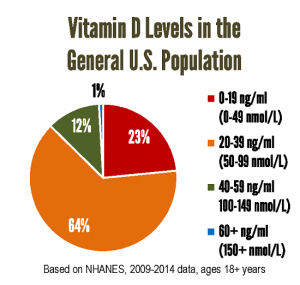Published on August 16, 2021
How do you know your best dose of vitamin D if you don’t follow each of these steps?
The knowledge surrounding vitamin D and its many health benefits has increased over the last several decades, with thousands of research papers already published to demonstrate its multiple effects.
Has this increased knowledge translated into better vitamin D status among the general population?
Minimal to No Improvement in Vitamin D Levels
 According to data from the National Health and Nutrition Examination Survey (NHANES), which collects health information from a representative sample of individuals living in the United States, the average vitamin D levels for those aged 18 years and older increased slightly from 25 ng/ml in 2001-2002 to 28 ng/ml in 2013-2014 (62 to 69 nmol/L). The percent of adults below 20 ng/ml (50 nmol/L) decreased from 26% to 23% during the same time period and those less than 40 ng/ml (100 nmol/L) decreased from 94% to 87%. While it is a slight improvement, these changes are minimal, still leaving almost 90% of the adult US population below recommended levels.
According to data from the National Health and Nutrition Examination Survey (NHANES), which collects health information from a representative sample of individuals living in the United States, the average vitamin D levels for those aged 18 years and older increased slightly from 25 ng/ml in 2001-2002 to 28 ng/ml in 2013-2014 (62 to 69 nmol/L). The percent of adults below 20 ng/ml (50 nmol/L) decreased from 26% to 23% during the same time period and those less than 40 ng/ml (100 nmol/L) decreased from 94% to 87%. While it is a slight improvement, these changes are minimal, still leaving almost 90% of the adult US population below recommended levels.
A recent publication by Kerber et al. looked at trends of vitamin D testing and levels over a 16 year period among children and teen residents of Olmsted County, Minnesota. They found that, regardless of a 42-fold increase in the amount of vitamin D testing done, vitamin D deficiency/insufficiency (levels below 20 ng/ml or 50 nmol/L) among those tested remained stable, with an increased incidence of deficiency/insufficiency overall.
How Could an Increase in Testing Result in No Improvement?
Several reasons are likely to contribute to this problem:
- Current recommendations for vitamin D intake are too low – most people are simply not taking enough vitamin D to reach the recommended level of 40-60 ng/ml (100-150 nmol/L), or even to correct a deficiency
- Everyone responds differently to vitamin D, so that the same dose recommendation will not achieve the same effect for all taking it
- The target vitamin D level is usually set too low, which also leaves little room for seasonal fluctuation in vitamin D levels
- Re-testing after initial supplementation and adjusting vitamin D intake to achieve the target level is lacking
There are certain steps that are essential to ensuring you have found the right dose of vitamin D and/or the right routine for the level you are trying to achieve. These steps include
- Test to find your current vitamin D level
- Determine the target level you want to aim for. Our scientists recommend a level between 40-60 ng/ml (100-150 nmol/L), however, some research indicates levels over 60 ng/ml may be beneficial for certain conditions such as autoimmune diseases and cancer.
- Calculate a suggested vitamin D intake based on your current level, target level, and weight using the vitamin D*calculator. Consider a loading dose as needed.
- Implement your new vitamin D supplement dose and/or routine (will you include sunshine or an indoor UVB device, increase vitamin D rich foods, etc.?)
- Re-test your levels to see how your vitamin D routine is working (this step is VITAL!). Adjust your vitamin D intake again if needed, or consider evaluating vitamin D co-nutrients or other factors if you did not achieve the result you expected. Re-test after 3-6 months or sooner if using a loading dose.
- Repeat until you have reached your target! Experts suggest testing a minimum of twice each year to make sure target levels are maintained, as levels tend to be highest at the end of summer and lowest at the end of winter.
These steps are the basis of the Vitamin D*action project with GrassrootsHealth!
Vitamin D Levels Among Individuals Educated About the Above Steps (compared to the general population)
These Steps WORK! When comparing vitamin D levels among the general US adult population to those of adults in the GrassrootsHealth cohort
- Adults in the GrassrootsHealth cohort have significantly higher levels than those in the NHANES cohort
- 58% of adults in the GrassrootsHealth cohort have levels at or above 40 ng/ml compared to 13% in the NHANES cohort
- 4% of adults in the GrassrootsHealth cohort have levels below 20 ng/ml compared to 23% in the NHANES cohort
When comparing vitamin D levels in children and teens in the NHANES cohort to the GrassrootsHealth cohort (ages <18):
- Children and teens in the GrassrootsHealth cohort have significantly higher levels than those in the NHANES cohort
- 47% of children and teens in the GrassrootsHealth cohort have levels at or above 40 ng/ml compared to 7% in the NHANES cohort
- 7% of children and teens in the GrassrootsHealth cohort have levels below 20 ng/ml compared to 16% in the NHANES cohort
- More than 90% of U.S. children and teens in the NHANES data set had a vitamin D level below the recommended range of 40-60 ng/ml
In Conclusion
Supplementation does not always provide the expected change in vitamin D level. It is vital to TEST, ADJUST, RE-TEST and REPEAT to make sure that the daily dose or vitamin D routine is effective at achieving and maintaining the desired target vitamin D level. For example, an analysis of 5,442 GrassrootsHealth participants who completed at least two vitamin D tests showed that two-thirds (67%) reached a vitamin D level of at least 40 ng/ml on their second test – leaving 1/3 of those who re-tested still below the 40 ng/ml target level.
There are certain times when an individual might want to re-test sooner (such as with loading dose, if you’ve been sick, etc.) – we will cover this in more detail in an upcoming post.
Testing is Important with Any Dose of Vitamin D
To be sure you are achieving your target vitamin D level (and not a level that is too low or too high for your health concerns), it is vital to measure! This is true for vitamin D as well as other nutrients.
 Having and maintaining healthy vitamin D levels and other nutrient levels can help improve your health now and for your future. Choose which to measure, such as your vitamin D, omega-3s, and essential minerals including magnesium, selenium and zinc, by creating your custom home test kit today. Take steps to improve the status of each of these measurements to benefit your overall health. You can also track your own intakes, symptoms and results to see what works best for YOU.
Having and maintaining healthy vitamin D levels and other nutrient levels can help improve your health now and for your future. Choose which to measure, such as your vitamin D, omega-3s, and essential minerals including magnesium, selenium and zinc, by creating your custom home test kit today. Take steps to improve the status of each of these measurements to benefit your overall health. You can also track your own intakes, symptoms and results to see what works best for YOU.
Enroll and test your levels today, learn what steps to take to improve your status of vitamin D (see below) and other nutrients and blood markers, and take action! By enrolling in the GrassrootsHealth projects, you are not only contributing valuable information to everyone, you are also gaining knowledge about how you could improve your own health through measuring and tracking your nutrient status, and educating yourself on how to improve it.
Help everyone Move Research into Practice with vitamin D and other nutrients! As a special birthday gift to everyone, in honor of the science, we have created a special scholarship fund for anyone to donate to that will go towards helping others participate. Your donation will allow anyone to get help with funding their participation when they need it.






